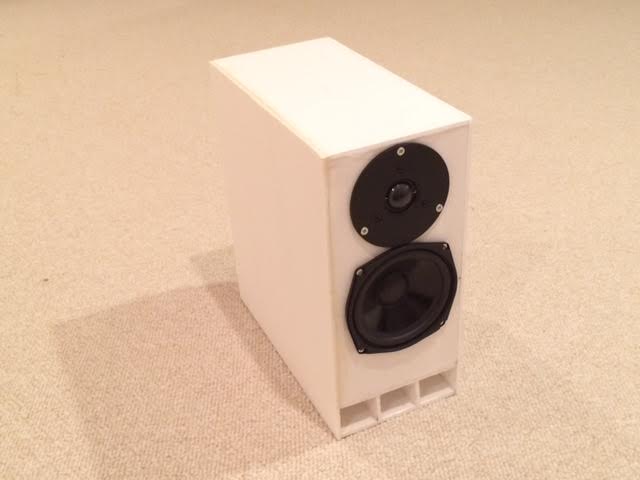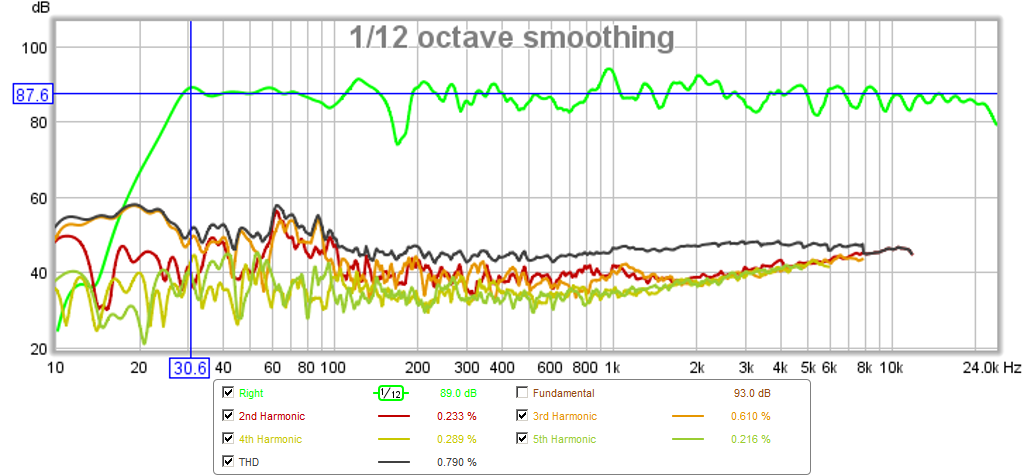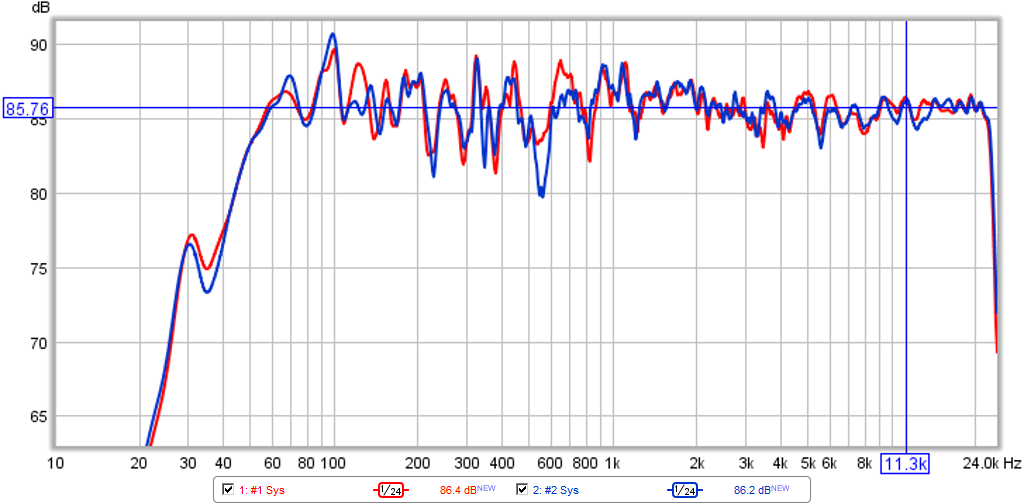I want to try out the open baffle concept but I dont have room for (2x stereo) 30cm wide baffles on my desktop. Instead I was thinking of putting a 2" fullrange speaker with a half baffle on each side of the 21" desktop screen. That way the screen itself would be part of the baffle..
I have bought a pair of Fountek FR58EX 2" Neodymium to test out this experiment and I already have a 12" inch woofer under the desktop. I originally wanted to try some fullranges in a FAST system but I also wanted to try open baffle. This way I get a little bit of both I hope to get down to 2-300Hz from the Founteks. The half baffle sides would have to be over 15cm wide (rough estimates). To slim them further perhaps I could build them in a half H -enclosure?? Xrk971, I got inspired by your recent build and wanted to try out the Fountek 2"
I hope to get down to 2-300Hz from the Founteks. The half baffle sides would have to be over 15cm wide (rough estimates). To slim them further perhaps I could build them in a half H -enclosure?? Xrk971, I got inspired by your recent build and wanted to try out the Fountek 2" 
If anyone have some thoughts on the layout of the wings, wall distance, crossover point etc. it would be fun to hear from you!
I have bought a pair of Fountek FR58EX 2" Neodymium to test out this experiment and I already have a 12" inch woofer under the desktop. I originally wanted to try some fullranges in a FAST system but I also wanted to try open baffle. This way I get a little bit of both
If anyone have some thoughts on the layout of the wings, wall distance, crossover point etc. it would be fun to hear from you!
Nice idea. Try to connect the baffle with the screen with something that doesn't transmit vibrations well. The plastic shell of the screen isn't made to sound good, and I you can't be sure how the electronics will react to constant vibrations over the years.
Something flexible in a thin strip just touching the screens back. That would also make it possible to "hinge" the baffles for toe in/out.
Just let them run fullrange. For nearfield you won't get much excursion anyway. With a compromised baffle (what baffle isn't) you'll need all the downward reach you can get to meet the sub.
H baffle I don't know about for fullrange. Maybe the front "wing" could be folded out partway to form half a waveguide?
Something flexible in a thin strip just touching the screens back. That would also make it possible to "hinge" the baffles for toe in/out.
Just let them run fullrange. For nearfield you won't get much excursion anyway. With a compromised baffle (what baffle isn't) you'll need all the downward reach you can get to meet the sub.
H baffle I don't know about for fullrange. Maybe the front "wing" could be folded out partway to form half a waveguide?
This reminds me of how I open baffle evaluate small full range drivers to assess how they sound before I include them into a box design. I attach the drivers to be tested to two pieces of foam board which are approximately 0.3 m square, I cut through holes for the drivers in each board and I affix their frames to the foam boards with painter tape for the testing. The foam test boards are then placed on stands in my listening room. I use a subwoofer (sealed box in my case) with a plate amp that has variable crossover frequencies for the R and L satellite line outputs to the test speakers which are acting as satellite speakers. I typically adjust the crossover frequency to 150 to 200 Hz for the subwoofer/satellite speaker cross. I then adjust the subwoofer gain control to match the output levels between the sub and two satellites.
Then I listen to this 2.1 system for my favorite music and decide how the small speakers sound for their mids and highs. I can tell very quickly how this system blends and whether the small drivers would adapt to my intended purpose. The open baffle is large enough for the smaller drivers to sound robust so you can judge the overall sound reproduction. My recent tests of the SBAcoustics 2.5 inch SB65 drivers has convinced me that this driver is a candidate for my next open baffle project. Of course with only one driver per side you have are limited attainable SPL, but as this is a near field situtation you would not use ear bleed sound levels.
In your case you can perhaps use cardboard or foam board which is cut to simulate a wide baffle and attach these pieces to your computer monitor. You can certainly use thin hardboard or whatever to produce a more eye pleasing set-up.
An H-frame implementation for an open baffle system is typically only used for the low end of the band because you excite dips (determined by the distance around the baffle) once you try to reproduce sound beyond the first dipole peak. Works great for a low end subwoofer/woofer but not so hot for mid range and above regions.
Then I listen to this 2.1 system for my favorite music and decide how the small speakers sound for their mids and highs. I can tell very quickly how this system blends and whether the small drivers would adapt to my intended purpose. The open baffle is large enough for the smaller drivers to sound robust so you can judge the overall sound reproduction. My recent tests of the SBAcoustics 2.5 inch SB65 drivers has convinced me that this driver is a candidate for my next open baffle project. Of course with only one driver per side you have are limited attainable SPL, but as this is a near field situtation you would not use ear bleed sound levels.
In your case you can perhaps use cardboard or foam board which is cut to simulate a wide baffle and attach these pieces to your computer monitor. You can certainly use thin hardboard or whatever to produce a more eye pleasing set-up.
An H-frame implementation for an open baffle system is typically only used for the low end of the band because you excite dips (determined by the distance around the baffle) once you try to reproduce sound beyond the first dipole peak. Works great for a low end subwoofer/woofer but not so hot for mid range and above regions.
Last edited:
Hi Impulse,
I just saw the thread. Neat idea and I think it can work. Test with foam core or cardboard (look for triple wall heavy duty appliance boxes). Use black electrical tape to seal gap at monitor edge. You can add a fold back wing in addition to main baffle. The trick is set as asymmetric position to reduce diffraction or have an angled trapezoidal baffle. Try at least 6in wide side baffle. Add 3in to 4in deep baffle to that. That should take you down to 350Hz. Now the trick is going to be to get your woofer to go up to 350Hz. I would forget about dipole bass and go monopole. What you get from your OB full range is a spacious open sound stage. It doesn't like a close back wall. 3 ft or more recommended.
Use any sealed or ported speaker box 8in or more for supporting bass. Anything smaller won't have enough bass.
You need a xo. Maybe passive line level 1st order at 350Hz? Need a smooth woofer with no crazy breakup at 2k. FR58EX can handle 1st order high pass at 350Hz. Also, it's ok to move up as high as 500Hz and enjoy FAST.
If you already have minidsp you are all set.
Good luck
I just saw the thread. Neat idea and I think it can work. Test with foam core or cardboard (look for triple wall heavy duty appliance boxes). Use black electrical tape to seal gap at monitor edge. You can add a fold back wing in addition to main baffle. The trick is set as asymmetric position to reduce diffraction or have an angled trapezoidal baffle. Try at least 6in wide side baffle. Add 3in to 4in deep baffle to that. That should take you down to 350Hz. Now the trick is going to be to get your woofer to go up to 350Hz. I would forget about dipole bass and go monopole. What you get from your OB full range is a spacious open sound stage. It doesn't like a close back wall. 3 ft or more recommended.
Use any sealed or ported speaker box 8in or more for supporting bass. Anything smaller won't have enough bass.
You need a xo. Maybe passive line level 1st order at 350Hz? Need a smooth woofer with no crazy breakup at 2k. FR58EX can handle 1st order high pass at 350Hz. Also, it's ok to move up as high as 500Hz and enjoy FAST.
If you already have minidsp you are all set.
Good luck
I've been running this for years now using Tang Band "bamboo" 3's and a generic 10" woofer, crossed over at 240 Hz. The panels are 11 inches wide and as tall as the monitor with stand. It works really well but if you leave the chair of course the low end goes away, while sounding quite a bit better in the bottom than just about anything other than headphones so long as you stay in the chair. Oddly, it seems to work better with a wall immediately (2-3') behind the desk. Weird but true. Also, don't even think of it with a corner desk. That definitely does not work better.
Thanks for all the excellent feedback! The woofer I have might sound good all the way up to 3-400hz, but I might create a new woofer screen stand if it doesnt work out. (I already have a box lifting the screen 10cm above the desk wich I could replace with a speaker.)
The biggest problem is that I have a wall 30cm behind the screen and another right wall 80cm from the screen.. Is that a huge issue? I also wonder if the woofer is very localizable at that high frequency?
Have anyone here tried to lower the backwave spl with som stuffing? Could that help in some way?
The biggest problem is that I have a wall 30cm behind the screen and another right wall 80cm from the screen.. Is that a huge issue? I also wonder if the woofer is very localizable at that high frequency?
Have anyone here tried to lower the backwave spl with som stuffing? Could that help in some way?
I would be concerned about open baffles if you have less than one meter behind the speakers. But, you can try out your ideas in your first post and find out if it works. None of us computer hackers 4000 or more miles away can evaluate your situation like you can.
One suggestion is to go with a small pair of box speakers (perhaps Overnight Sensations or even smaller) which can be mounted on each side of the desktop screen. Use the under the desktop woofer to cover the low end of the band while crossing to the small satellite speakers to cover 200-300 Hz and above. Likely the satellites can be very small boxed speakers if you crossover that high.
One suggestion is to go with a small pair of box speakers (perhaps Overnight Sensations or even smaller) which can be mounted on each side of the desktop screen. Use the under the desktop woofer to cover the low end of the band while crossing to the small satellite speakers to cover 200-300 Hz and above. Likely the satellites can be very small boxed speakers if you crossover that high.
Cardboard or foam core and tape here is all you should try. It will give you an immediate assessment of the sound quality and if workable. Like I said, with back wall that close - I would go with something else.
This is my current PC speaker and it rocks. Clear, vivid, quasi transient perfect. No sub needed as the TL and room gain/desk gain gives me flat to 30Hz.
http://www.diyaudio.com/forums/multi-way/281778-low-cost-pmc-inspired-tl-monitor-dc130a-dc28f.html

This is measured at the LP (my head when looking at monitor) - a lot of dips and peaks are reflection of desk, lamp, keyboard, etc on desk:

Here is measurement in semi 4pi with minimized reflections:

This is my current PC speaker and it rocks. Clear, vivid, quasi transient perfect. No sub needed as the TL and room gain/desk gain gives me flat to 30Hz.
http://www.diyaudio.com/forums/multi-way/281778-low-cost-pmc-inspired-tl-monitor-dc130a-dc28f.html

This is measured at the LP (my head when looking at monitor) - a lot of dips and peaks are reflection of desk, lamp, keyboard, etc on desk:

Here is measurement in semi 4pi with minimized reflections:

Last edited:
- Status
- This old topic is closed. If you want to reopen this topic, contact a moderator using the "Report Post" button.
- Home
- Loudspeakers
- Full Range
- PC screen as part of open baffle.